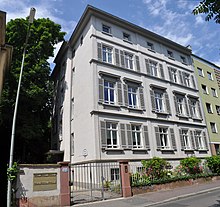Im Trutz Frankfurt
| Im Trutz Frankfurt | |
|---|---|
| Street in Frankfurt am Main | |
| Section between Gärtnerweg and Emil-Claar-Straße | |
| Basic data | |
| place | Frankfurt am Main |
| District | West end |
| Created | 1856 |
| Connecting roads | Bockenheimer Anlage (beginning), Gervinusstraße (end) |
| Cross streets | Gärtnerweg, Emil-Claar-Straße, Grüneburgweg |
| Buildings | Westend Carrée |
| Technical specifications | |
| Street length | 553 m |

Im Trutz Frankfurt is a street laid out in 1856 in the Westend district of Frankfurt . Its name refers to a siege of the city that took place in 1552.
location
The southern end of the street is at number 13 of the Bockenheimer facility . From there, the road initially runs in a north-easterly direction to Gärtnerweg and then in an almost northerly direction to Gervinusstraße. It is then continued in a roughly north-westerly direction through the street Auf der Körnerwiese . In the last section between Grüneburgweg and Gervinusstraße, the street runs between mostly modern buildings. These include Westend Carrée on the western edge of the road - a building complex built in 1990 that occupies the entire block between Im Trutz Frankfurt (in the east), Gervinusstrasse (in the north), Grüneburgweg (in the south) and Leerbachstrasse (in the west) - and one in the east the road situated Rewe - supermarket adjacent to the entrance at Grüneburgweg number 12. for more plots are the rear gardens belonging to the Körnerstraße houses with points 3 to 11th
history
The name means defiance or resistance and, together with the east running parallel street Im Sachsenlager, recalls an incident in July 1552. The Protestant princes under the leadership of Elector Moritz von Sachsen had risen in the prince revolt against the emperor and besieged the Lutheran city for three weeks Frankfurt, which was defended by Catholic troops led by Colonel Conrad von Hanstein . The city defied the request to open its city gates for the princely army that had settled in the fields in front of the city. Only the Passau Treaty of July 29, 1552 ended the siege.
During the time of National Socialism , the Ignatius congregation , looked after by Jesuits , maintained a symbolic address at the (non-existent) house number 50. This corresponds to the last section of the street north of Grüneburgweg, on the east side of which the street has no houses of its own. The last house on the east side of the street is located south of Grüneburgweg and is number 48.
In 1901, Frankfurt schoolgirls were given the opportunity to graduate from high school for the first time on this street . In the spring of 1900 the “ Verein Frauenbildung-Frauenstudium ” approached the citizens of Frankfurt with an appeal for donations and on April 14, 1901, offered a first “secondary school course for girls” in a private apartment at Im Trutz 18. The first class of 12 girls pioneered a series of private schools in Frankfurt. The magistrate fulfilled the demand for the creation of a municipal high school for girls at Easter 1908 with the creation of the Schillerschule as a girls' high school .
Distinctive points
The Frankfurt telephone directory, first published in 1881, contained a list of the city's first 131 connections. The connection with the number 1 belonged to a Freiherr von Erlanger who lived in Im Trutz 12 . In front of house number 13 there is a stumbling block for Friederike Wreschner born. Klaber (1888–1945), who lived in a villa at this address between 1922 and 1935 together with her husband, the industrialist Leo Lippmann Wreschner, and their two daughters Charlotte and Margrit.
Silvia Tennenbaum (* 1928, author of the novel Streets of Yesterday ) lived at number 33 on the street from 1934 until she fled to Switzerland in 1936.
This late classicist tenement house from around 1859 is a listed building . The neighboring tenement house of the Romantic Late Classicism from the same period with number 31. The house was originally a parsonage of the French Reformed community.
Web links
Individual evidence
- ^ Kurt Wahlig: Das Frankfurter Straßenennamen-Büchlein , Verlag Waldemar Kramer, Frankfurt am Main, 1963, p. 80
- ↑ Kurt Schäfer: Schools and School Policy in Frankfurt am Main 1900-1945, Volume 35 of Studies on Frankfurt History , 1994, ISBN 9783782904537 , pp. 38–40
- ^ Institute for City History Frankfurt am Main (ed.): Degussa files. Directory of those involved in the telephone installation. Frankfurt am Main 1881, p. 29
- ↑ Stolpersteine Frankfurt: Wreschner, Friederike accessed on Feb. 22, 2020
- ↑ Frankfurt is reading a book: A city tour with Silvia Tennenbaum (article from April 17, 2012)
- ↑ Frankfurt is reading a book: Streets of Yesterday ( Memento of the original from February 23, 2014 in the Internet Archive ) Info: The archive link was inserted automatically and has not yet been checked. Please check the original and archive link according to the instructions and then remove this notice. (Article of April 17, 2012)
Coordinates: 50 ° 7 '10.4 " N , 8 ° 40' 26.1" E

